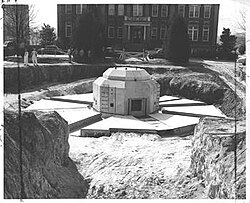| Pulstar | |
|---|---|
 Picture of R-1 reactor while under construction [1] | |
| Operating Institution | North Carolina State University |
| Location | Raleigh, North Carolina |
| Type | pool |
| Power | 1 MW (thermal) |
| Construction and Upkeep | |
| Construction Cost | $1.5 million USD |
| Construction Began | June 1, 1969 |
| First Criticality | January 1, 1972 |
| Staff | 7 |
| Operators | 3 |
| Technical Specifications | |
| Max Thermal Flux | 1.1e13 n/cm^2-s |
| Fuel Type | U02 pellets, pin lattice |
| Cooling | n/cm^2-s |
| Neutron Moderator | light water |
| Neutron Reflector | graphite, beryllium |
| Control Rods | 4 Rods |
| Cladding Material | Zirconium Alloy |
| Source(s): IAEA Database of Reactors data from 2002-09-04 | |
North Carolina State University in 1950 founded the first university-based reactor program and Nuclear Engineering curriculum in the United States. The program continues in the early 21st century. That year, NC State College administrators approved construction of a reactor and the establishment of a collegiate nuclear engineering program.[2] The first research reactor was completed in 1953;[3] it was scaled up in 1957 and 1960 (referred to as R-1, R-2, and R-3). It was deactivated in 1973 to make way for the PULSTAR reactor. The old reactor has been decommissioned.
The PULSTAR is used for a variety of purposes, including training and research. The reactor is located in Burlington Engineering Laboratories on NCSU's main campus. This facility was built to house the first reactor and then expanded and renamed when the PULSTAR was built. The current reactor is one of two PULSTAR reactors built, and the only one still in operation. The other reactor was a 2 MW reactor at the State University of New York at Buffalo. It went critical in 1964 and was decommissioned in 1994.[4]
- ^ "R-1 reactor", University Archives
- ^ "Nuclear engineering program approved (1950)". Historical State: History in Red and White. NCSU Special Collections Research Center. Retrieved 11 January 2012.
- ^ "Nuclear reactor goes into operation (9/5/1953)". Historical State: History in Red and White. NCSU Libraries Special Collections Research Center. Retrieved 11 January 2012.
- ^ IAEA Database of Reactors "Nuclear Research Reactors in the World". Archived from the original on 2008-05-16. Retrieved 2008-06-11., data from 2002-09-04